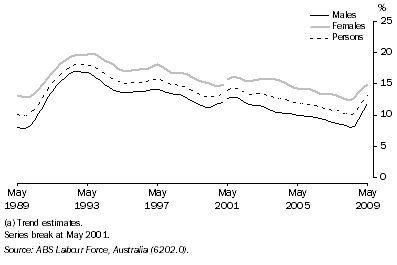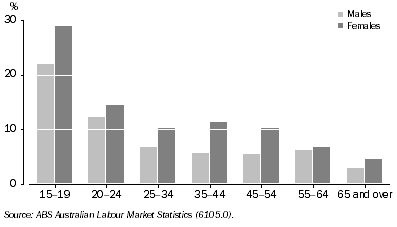UNDERUTILISED LABOUR
The extent to which the available supply of labour is utilised is an important social and economic issue. From a social viewpoint, concern centres around the number of people whose aspirations for work are not being met. From an economic perspective, there is interest in measuring the extent to which available labour resources are not being fully utilised within the economy.
Measures such as the unemployment rate and long-term unemployment rate do not reflect the full extent of labour underutilisation. As a result, the ABS also produces labour underutilisation measures based on the number of people whose labour is underutilised (headcount measures), and the number of hours of available labour that are underutilised (volume measures). These measures take into account groups of people such as underemployed workers and discouraged jobseekers.
Headcount measures of labour underutilisation
The ABS has produced three supplementary measures of labour underutilisation which are formed by combining information on unemployed people with that of other groups whose labour is underutilised:
Underemployment rate - the number of underemployed workers as a proportion of the labour force. Underemployed people comprise part-time workers who would prefer more hours, and are available to work more hours, and full-time workers who worked part-time hours in the reference week for economic reasons.
Labour force underutilisation rate - the sum of the unemployed and the underemployed (the underutilised population), expressed as a proportion of the labour force.
Extended labour force underutilisation rate - the sum of the unemployed, the underemployed, and two groups of people marginally attached to the labour force, as a proportion of the labour force augmented by those two groups. The two groups of marginally attached people are: people actively looking for work, not available to start work in the reference week, but available to start within four weeks; and discouraged jobseekers. This is the broadest of the ABS measures of underutilised labour.
Table 8.38 shows there were more than half a million (634,500) underemployed people in August 2008. The underemployment rate was higher for women than men (7.6% and 4.0% respectively). This is related to the higher proportion of women who are in part-time employment.
The labour force underutilisation rate was 9.6% in August 2008. Women had a higher labour force underutilisation rate than men (11.9% compared with 7.6%), reflecting their higher rate of underemployment. Underemployment contributed more people to the total number of people considered to be underutilised (634,500, or 59%) than unemployment (432,600, or 41%).
In August 2008 the extended labour force underutilisation rate was 10.6%. The extended labour force underutilisation rate was higher for women than men (13.2% compared with 8.5%), not only because women had a higher rate of underemployment, but also because women were more likely to be in the marginally attached populations that contribute to this rate.
8.38 LABOUR UNDERUTILISATION - August 2008 |
|
 |  |  | Males | Females | Persons |
|
| Unemployed | '000 | 218.0 | 214.5 | 432.6 |
 | Long-term unemployed | '000 | 30.0 | 33.5 | 63.5 |
| Underemployed | '000 | 246.2 | 388.3 | 634.5 |
| Marginally attached to the labour force(a) | '000 | 58.0 | 75.3 | 133.2 |
| Labour underutilisation rates |  |  |  |  |
 | Unemployment rate | % | 3.6 | 4.2 | 3.9 |
 | Long-term unemployment rate | % | 0.5 | 0.7 | 0.6 |
 | Underemployment rate | % | 4.0 | 7.6 | 5.7 |
 | Labour force underutilisation rate | % | 7.6 | 11.9 | 9.6 |
 | Extended labour force underutilisation rate | % | 8.5 | 13.2 | 10.6 |
|
| (a) Includes only a subset of marginally attached groups. |
| Source: ABS Australian Labour Market Statistics, (6105.0), ABS Labour Force, Australia, Detailed - Electronic Delivery (6291.0.55.003). |
The trend historical labour force underutilisation rate shows a number of periods in which underutilisation has been an increasing or decreasing concern for the labour market, and these closely align with the peaks and troughs of the economic cycle. Graph 8.39 shows the relatively steep increase in the early 1990s, and a sharp increase from May 2008 to May 2009.
The pattern of labour force underutilisation has been similar since May 1989, with the rate for women consistently higher than for men. The difference was most pronounced in February 2004, with a different of 5.3 percentage points (15.7% for women and 10.4% for men), and least pronounced in November 1992, with a difference of 2.6 percentage points (19.6% and 17.0% respectively).
8.39 Labour force underutilisation rate(a), By sex

The labour force underutilisation rate decreases with age. As seen in graph 8.40, in August 2008, 15-19 year olds had the highest underutilisation rate (25.4%), followed by 20-24 year olds (13.2%), whereas the lowest rate was for people aged 65 and over (3.4%), a pattern reflected in both the unemployment rate and the underemployment rate. Underutilisation was higher for women than for men in all age groups.
8.40 Labour Force Underutilisation Rate, By age and sex
- August 2008

Volume measures of labour force underutilisation
Labour underutilisation can also be measured in terms of the number of potential hours of labour that are not used. The volume of underutilised labour in the labour force is defined as the number of hours sought by unemployed people plus the preferred number of additional hours of work of underemployed workers. The volume labour force underutilisation rate is the ratio of unutilised hours to the total number of utilised and unutilised hours in the labour force.
Table 8.41 shows volume measures of labour force underutilisation for August 2008. For all three underutilisation measures ( i.e. unemployment, underemployment and labour force underutilisation), the volume measures are usually lower than headcount measures, as the average number of potential extra hours of unemployed or underemployed people is generally less than the average hours actually worked by employed people.
In August 2008, the hours sought by unemployed people (13.5 million hours) formed the largest component of the volume of underutilised labour in the labour force (61%), while additional hours preferred by underemployed formed the remainder (8.8 million hours or 39% of the volume of underutilised labour). As with the headcount measure, underemployed hours for women comprised a larger proportion (45%) of female underutilised labour than for men (34%).
8.41 VOLUME MEASURES OF LABOUR UNDERUTILISATION - August 2008 |
|
 |  |  | Males | Females | Persons |
|
| Volume of potential labour in the labour force |  |  |  |  |
 | Unemployed persons (hours of work sought) | million hours | 7.5 | 6.1 | 13.5 |
 | Underemployed workers (additional hours of work preferred) | million hours | 3.8 | 5.0 | 8.8 |
 | Employed persons (hours worked)(a) | million hours | 242.8 | 152.3 | 395.1 |
 | Total(b) | million hours | 254.0 | 163.5 | 417.4 |
| Volume measures of labour force underutilisation |  |  |  |  |
 | Volume unemployment rate | % | 2.9 | 3.7 | 3.2 |
 | Volume underemployment rate | % | 1.5 | 3.1 | 2.1 |
 | Volume labour force underutilisation rate | % | 4.4 | 6.8 | 5.3 |
|
| (a) Actual hours worked in the reference week for underemployed full-time workers and usual hours worked for all other employed persons. |
| (b) The volume of potential labour in the labour force is equal to the hours of labour sought by unemployed persons, plus the hours of labour preferred by underemployed workers (both utilised and unutilised), plus the hours of labour usually provided by employed persons who are not underemployed. |
| Source: ABS Australian Labour Market Statistics (6105.0). |
 Print Page
Print Page